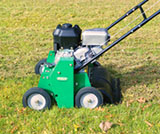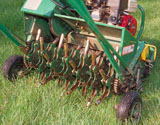Power Raking / De-thatching
 Power Raking is, in a nut shell, the process of removing the unhealthy thatch layer that has accumulated on your lawn. Power Rakes work by using a series of blades (somewhat like knives) that move up and down, breaking up the thatch layer and bringing it to the surface where it can be raked up and removed. Thatch refers to the accumulation of dead grass trimmings/dead grass roots that have piled up to form a barrier between the surface of the grass and the actual soil. A small, thin layer of thatch can actually benefit your lawn by helping to keep the moisture in the soil from evaporating. However once Spring rolls around, most lawns have accumulated an unhealthy (thick) layer of thatch which, if left unchecked, will reduce the amount of nutrients that your lawn can receive as the thatch barrier actually prevents water and nutrients from reaching the soil before evaporating. Over time, a thick layer of thatch will cause the root structure of your lawn to thin out as the grass essentially starves from lack of nutrients – which will lead to weeds germinating in your lawn and bare spots in your grass. Power Raking (also called de-thatching) is an essential part of a healthy lawn and should be performed once a year in the early spring (April & May). Now that you know just how important this service is, why not visit our ordering page and get yourself a Calgary Spring Clean Up package with Power Raking! Your lawn will thank you!
Power Raking is, in a nut shell, the process of removing the unhealthy thatch layer that has accumulated on your lawn. Power Rakes work by using a series of blades (somewhat like knives) that move up and down, breaking up the thatch layer and bringing it to the surface where it can be raked up and removed. Thatch refers to the accumulation of dead grass trimmings/dead grass roots that have piled up to form a barrier between the surface of the grass and the actual soil. A small, thin layer of thatch can actually benefit your lawn by helping to keep the moisture in the soil from evaporating. However once Spring rolls around, most lawns have accumulated an unhealthy (thick) layer of thatch which, if left unchecked, will reduce the amount of nutrients that your lawn can receive as the thatch barrier actually prevents water and nutrients from reaching the soil before evaporating. Over time, a thick layer of thatch will cause the root structure of your lawn to thin out as the grass essentially starves from lack of nutrients – which will lead to weeds germinating in your lawn and bare spots in your grass. Power Raking (also called de-thatching) is an essential part of a healthy lawn and should be performed once a year in the early spring (April & May). Now that you know just how important this service is, why not visit our ordering page and get yourself a Calgary Spring Clean Up package with Power Raking! Your lawn will thank you!
Core Aeration
 Core Aeration is essentially the process of making small cylindrical “holes” in your lawn to allow nutrients to reach the root system while reducing compaction of your lawn. Most aerators are gas powered, with a “wheel” full of hollow metal spikes that is driven on your lawn in a effort to pull out plugs from your lawn via the hollow metal spikes (usually referred to as tines). These plugs are left on the lawn and dissolve back into the lawn in about 3 weeks, all the while providing a healthy supply of nutrients that not only benefits the root structure of your lawn but also assists in reducing thatch. Core Aeration greatly benefits your lawn by allowing water and other nutrients direct access to the root structure, which in turn helps your grass grow deeper, thicker roots. A lawn with deep, thick roots is more resistant to drought, weeds, physical damage (ie: people walking on it) and on top of that, thick lawns look pretty darn good! Core Aeration also reduces the compaction of your lawn. Over time your lawn will naturally become compressed (or compacted) and that will create a lot of resistance for water and other nutrients trying to travel down through the soil. As a result, lawns with compacted soil usually have very shallow root structure and in turn are usually quite weak. A shallow root structure caused by compaction puts your lawn at risk for drought, weed growth and bare spots. Core Aeration can solve all of these problems and is a key factor in producing a healthy, beautiful lawn! Core Aeration should be performed once a year in the spring or fall (April – May or Sept. – Oct.). We have several different packages that include Core Aeration, ranging from our Calgary Spring Clean Up package to our Calgary Fertilizer and Weed Control packages! Or you can always just order Core Aeration on its own! Book your service today to insure a beautiful, thick green lawn this season!
Core Aeration is essentially the process of making small cylindrical “holes” in your lawn to allow nutrients to reach the root system while reducing compaction of your lawn. Most aerators are gas powered, with a “wheel” full of hollow metal spikes that is driven on your lawn in a effort to pull out plugs from your lawn via the hollow metal spikes (usually referred to as tines). These plugs are left on the lawn and dissolve back into the lawn in about 3 weeks, all the while providing a healthy supply of nutrients that not only benefits the root structure of your lawn but also assists in reducing thatch. Core Aeration greatly benefits your lawn by allowing water and other nutrients direct access to the root structure, which in turn helps your grass grow deeper, thicker roots. A lawn with deep, thick roots is more resistant to drought, weeds, physical damage (ie: people walking on it) and on top of that, thick lawns look pretty darn good! Core Aeration also reduces the compaction of your lawn. Over time your lawn will naturally become compressed (or compacted) and that will create a lot of resistance for water and other nutrients trying to travel down through the soil. As a result, lawns with compacted soil usually have very shallow root structure and in turn are usually quite weak. A shallow root structure caused by compaction puts your lawn at risk for drought, weed growth and bare spots. Core Aeration can solve all of these problems and is a key factor in producing a healthy, beautiful lawn! Core Aeration should be performed once a year in the spring or fall (April – May or Sept. – Oct.). We have several different packages that include Core Aeration, ranging from our Calgary Spring Clean Up package to our Calgary Fertilizer and Weed Control packages! Or you can always just order Core Aeration on its own! Book your service today to insure a beautiful, thick green lawn this season!